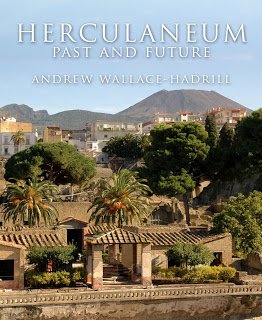The Death of Two Cities
 We’ve all heard of Pompeii, the city buried when Mt. Vesuvius blew its top in A.D. 79. But a much smaller number of us have heard of Herculaneum. To be honest (I’ll show my ignorance here), I'd never heard of it till I started checking out info on its buried sister city a year ago. When Mt. Vesuvius erupted around 1 PM that autumn, the southeast wind blew pumice and ash over Pompeii, burying it. But it wasn’t till after midnight that night in nearby (and closer to the summit) Herculaneum that a flow of heated gas rolled down the mountain and fried everything in its path. For years experts thought everybody must have escaped in Herculaneum, because archaeologists found only a few skulls. But within the past few decades, a huge number of human remains have been discovered down at the waterfront. Apparently most people fled to the harbor and hid under the arches holding up the boardwalk. Shoulda been safe, huh? Well, not when a rolling 700-degree fire descends on you. A cool thing about Herculaneum is that the fire was hot enough to kill (bad), but not so hot as to incinerate everything (good). This means that two thousand years later, archaeologists are uncovering carbonized wooden beds and house beams as well as entire loaves of bread! Many of the emblems of daily life have survived. Totally rare. And fascinating.
We’ve all heard of Pompeii, the city buried when Mt. Vesuvius blew its top in A.D. 79. But a much smaller number of us have heard of Herculaneum. To be honest (I’ll show my ignorance here), I'd never heard of it till I started checking out info on its buried sister city a year ago. When Mt. Vesuvius erupted around 1 PM that autumn, the southeast wind blew pumice and ash over Pompeii, burying it. But it wasn’t till after midnight that night in nearby (and closer to the summit) Herculaneum that a flow of heated gas rolled down the mountain and fried everything in its path. For years experts thought everybody must have escaped in Herculaneum, because archaeologists found only a few skulls. But within the past few decades, a huge number of human remains have been discovered down at the waterfront. Apparently most people fled to the harbor and hid under the arches holding up the boardwalk. Shoulda been safe, huh? Well, not when a rolling 700-degree fire descends on you. A cool thing about Herculaneum is that the fire was hot enough to kill (bad), but not so hot as to incinerate everything (good). This means that two thousand years later, archaeologists are uncovering carbonized wooden beds and house beams as well as entire loaves of bread! Many of the emblems of daily life have survived. Totally rare. And fascinating.
Until last week, I used a 1966 book about Herculaneum—the most recent English-language resource—to help me reconstruct the eruption for a novel I’m writing. But then I heard about Andrew Wallace-Hadrill’s 2011 release on Herculaneum. He’s a mega-expert on Herculaneum, who was interviewed on PBS’s home video about Herculeneum in their “Secrets of the Dead” series. I ordered his book on Amazon for $37 (hardcover), expecting a reference work. But what arrived was a gorgeous coffee-table book, chock full of foldout pictures, diagrams, and fascinating prose. Plus it has all the latest info, some of which completely contradicts earlier assumptions, which means I’m rewriting a few scenes. But not matter—this book is a gold mine. We have assumed in the past that Pompeii showed us the norm of first-century life. But with the past decade of discovery in Herculaneum, we now know that Pompeii was more populated and urban, and Herculaneum was smaller and wealthier. It’s city vs. town, urban metropolis vs. resort spot. Pompeii had the brothels; Herculaneum did not. Pompeii had lots of graffiti; Herculaneum did not. Picture the difference between Vegas and Pebble Beach and you get the idea about how much we should extrapolate about "norms" from one city's evidence.
